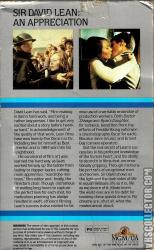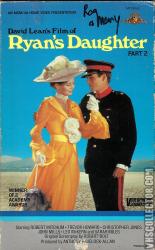Ryan's Daughter
Catalog Number
MV700163
-
Primary Distributor (If not listed, select "OTHER")
Catalog Number
MV700163
Primary Distributor (If not listed, select "OTHER")
Release Year
Country
N/A (NTSC)
N/A | N/A | N/A
N/A | N/A
Ryan's Daughter (1970)
Additional Information
Additional Information
A story of love...set against the violence of rebellion
From MGM, producers of David Lean's "Doctor Zhivago"
A story of love. Filmed by David Lean.
The logic behind inflating Robert Bolt's minimalist romantic drama Ryan's Daughter into a 12-million-dollar epic seems to have been "When David Lean directs, it's a super-spectacular." Sarah Miles (who at the time was married to Robert Bolt) stars as Rosy, the daughter of Irish pub keeper Tom Ryan (Leo McKern). Married to tweedy, sexless schoolmaster Charles Shaughnessy (Robert Mitchum), restless Rosy has an affair with British officer Randolph Doryan (Christopher Jones). When village idiot Michael (an Oscar-winning turn by John Mills) innocently uncovers evidence of Rosy's indiscretion, the local gossips begin wagging their tongues. Shaughnessy chooses to remain above the scandal, assuming that Rosy will come to her senses. Later, Rosy's father informs on a group of IRA insurgents, hoping to keep the peace in his village. The locals assume that Rosy, still enamored of Doryan, is the informer, and exact a humiliating punishment. Realizing that his very presence has caused disgrace for Rosy, Doryan kills himself. For Rosy and Shaughnessy, life goes on...not happily ever after, just ever after. The film was lensed on location in Ireland by frequent Lean collaborator Freddie Young.
Ryan's Daughter is a 1970 film directed by David Lean.[4][5] The film, set in 1916, tells the story of a married Irish woman who has an affair with a British officer during World War I, despite opposition from her nationalist neighbours. The film is a very loose adaptation of Gustave Flaubert's novel Madame Bovary.
The film stars Robert Mitchum, Sarah Miles, John Mills, Christopher Jones, Trevor Howard and Leo McKern, with a score by Maurice Jarre. It was photographed in Super Panavision 70 by Freddie Young.
In its initial release, Ryan's Daughter was harshly received by critics[1] but was a box office success, grossing nearly $31 million[3] on a budget of $13.3 million, making the film the eighth highest-grossing picture of 1970. It received two Academy Awards.
he MPAA originally gave Ryan's Daughter an "R" rating. A nude scene between Miles and Jones, as well as its themes involving infidelity, were the primary reasons for the MPAA's decision.[8] At the time, MGM was having financial trouble and appealed the rating not due to artistic reasons but due to financial reasons.
At the appeal hearing, MGM executives explained that they needed the lower rating to allow more audience into the theatres, otherwise the company would not be able to survive financially. The appeal was overturned and the film received a "GP" rating, which later became "PG". Jack Valenti considered this to be one of the tarnishing marks on the rating system.[9] When MGM resubmitted the film to the MPAA in 1996, it was re-rated "R".
The film is rated M in Australia and M in New Zealand and contains sexual themes where it was originally rated PG in Australia and PG in New Zealand.
Upon its initial release, the film received a hostile reception from the critical community. Roger Ebert felt that "Lean's characters, well written and well acted, are finally dwarfed by his excessive scale."[10]
Many attribute the bad reviews to critics' expectations being too high as Lean had directed three epics in a row before Ryan's Daughter. The preview cut, which ran to over 220 minutes, was criticised for its length and poor pacing; Lean felt obliged to remove up to 17 minutes of footage before the film's wide release, and the missing footage has not been restored or located. Lean took these criticisms very personally, and claimed at the time that he would never make another film.[citation needed](Others dispute this, citing the fact that Lean tried but was unable to get several projects off the ground, most notably The Bounty.) The film was moderately successful worldwide at the box office and was one of the most successful films of 1970 in Britain, where it ran at a West End theatre for almost two years straight.
The film has also been criticised for its perceived depiction of the Irish proletariat as uncivilised compared with the occupying British forces and the Catholic Church. An Irish commentator has since described them in 2008 as ".. the local herd-like and libidinous populace who lack gainful employment to keep them occupied."[11] Some criticised the film as an attempt to blacken the legacy of the 1916 Easter Rising and the subsequent Irish War of Independence in relation to the eruption of "the Troubles" in Northern Ireland at the time of the film's release, but approval of the project had started years before the Troubles. The depiction of the mob stripping and cutting the hair off Rosy, while gratuitously holding and punching her husband brings to mind the historical examples of 1944's liberated France, where after Liberation, women accused of having slept with German soldiers were often mistreated.
Since the film's release on DVD, Ryan's Daughter has been reconsidered by many critics, now claimed by many to be an overlooked masterpiece, countering many of the criticisms such as its alleged "excessive scale". Other elements, like John Mills' caricature of 'the village idiot' (an Oscar-winning performance) have withstood the test of time less well.[12] The film is still not as widely accepted as Lean's other epics and its critical reputation remains mixed at best. It stands out from his previous work, being characterised by a slower pace, more expansive and allegorical directing, with less dialogue than in previous films, though the film builds tension, albeit slowly.
Release Date: November 21, 1970
Distrib: MGM
Boxoffice: $30,846,306 2013: $160,201,863
From MGM, producers of David Lean's "Doctor Zhivago"
A story of love. Filmed by David Lean.
The logic behind inflating Robert Bolt's minimalist romantic drama Ryan's Daughter into a 12-million-dollar epic seems to have been "When David Lean directs, it's a super-spectacular." Sarah Miles (who at the time was married to Robert Bolt) stars as Rosy, the daughter of Irish pub keeper Tom Ryan (Leo McKern). Married to tweedy, sexless schoolmaster Charles Shaughnessy (Robert Mitchum), restless Rosy has an affair with British officer Randolph Doryan (Christopher Jones). When village idiot Michael (an Oscar-winning turn by John Mills) innocently uncovers evidence of Rosy's indiscretion, the local gossips begin wagging their tongues. Shaughnessy chooses to remain above the scandal, assuming that Rosy will come to her senses. Later, Rosy's father informs on a group of IRA insurgents, hoping to keep the peace in his village. The locals assume that Rosy, still enamored of Doryan, is the informer, and exact a humiliating punishment. Realizing that his very presence has caused disgrace for Rosy, Doryan kills himself. For Rosy and Shaughnessy, life goes on...not happily ever after, just ever after. The film was lensed on location in Ireland by frequent Lean collaborator Freddie Young.
Ryan's Daughter is a 1970 film directed by David Lean.[4][5] The film, set in 1916, tells the story of a married Irish woman who has an affair with a British officer during World War I, despite opposition from her nationalist neighbours. The film is a very loose adaptation of Gustave Flaubert's novel Madame Bovary.
The film stars Robert Mitchum, Sarah Miles, John Mills, Christopher Jones, Trevor Howard and Leo McKern, with a score by Maurice Jarre. It was photographed in Super Panavision 70 by Freddie Young.
In its initial release, Ryan's Daughter was harshly received by critics[1] but was a box office success, grossing nearly $31 million[3] on a budget of $13.3 million, making the film the eighth highest-grossing picture of 1970. It received two Academy Awards.
he MPAA originally gave Ryan's Daughter an "R" rating. A nude scene between Miles and Jones, as well as its themes involving infidelity, were the primary reasons for the MPAA's decision.[8] At the time, MGM was having financial trouble and appealed the rating not due to artistic reasons but due to financial reasons.
At the appeal hearing, MGM executives explained that they needed the lower rating to allow more audience into the theatres, otherwise the company would not be able to survive financially. The appeal was overturned and the film received a "GP" rating, which later became "PG". Jack Valenti considered this to be one of the tarnishing marks on the rating system.[9] When MGM resubmitted the film to the MPAA in 1996, it was re-rated "R".
The film is rated M in Australia and M in New Zealand and contains sexual themes where it was originally rated PG in Australia and PG in New Zealand.
Upon its initial release, the film received a hostile reception from the critical community. Roger Ebert felt that "Lean's characters, well written and well acted, are finally dwarfed by his excessive scale."[10]
Many attribute the bad reviews to critics' expectations being too high as Lean had directed three epics in a row before Ryan's Daughter. The preview cut, which ran to over 220 minutes, was criticised for its length and poor pacing; Lean felt obliged to remove up to 17 minutes of footage before the film's wide release, and the missing footage has not been restored or located. Lean took these criticisms very personally, and claimed at the time that he would never make another film.[citation needed](Others dispute this, citing the fact that Lean tried but was unable to get several projects off the ground, most notably The Bounty.) The film was moderately successful worldwide at the box office and was one of the most successful films of 1970 in Britain, where it ran at a West End theatre for almost two years straight.
The film has also been criticised for its perceived depiction of the Irish proletariat as uncivilised compared with the occupying British forces and the Catholic Church. An Irish commentator has since described them in 2008 as ".. the local herd-like and libidinous populace who lack gainful employment to keep them occupied."[11] Some criticised the film as an attempt to blacken the legacy of the 1916 Easter Rising and the subsequent Irish War of Independence in relation to the eruption of "the Troubles" in Northern Ireland at the time of the film's release, but approval of the project had started years before the Troubles. The depiction of the mob stripping and cutting the hair off Rosy, while gratuitously holding and punching her husband brings to mind the historical examples of 1944's liberated France, where after Liberation, women accused of having slept with German soldiers were often mistreated.
Since the film's release on DVD, Ryan's Daughter has been reconsidered by many critics, now claimed by many to be an overlooked masterpiece, countering many of the criticisms such as its alleged "excessive scale". Other elements, like John Mills' caricature of 'the village idiot' (an Oscar-winning performance) have withstood the test of time less well.[12] The film is still not as widely accepted as Lean's other epics and its critical reputation remains mixed at best. It stands out from his previous work, being characterised by a slower pace, more expansive and allegorical directing, with less dialogue than in previous films, though the film builds tension, albeit slowly.
Release Date: November 21, 1970
Distrib: MGM
Boxoffice: $30,846,306 2013: $160,201,863
Related Links






Comments0
Login / Register to post comments